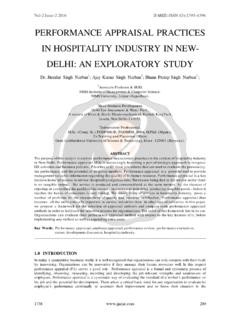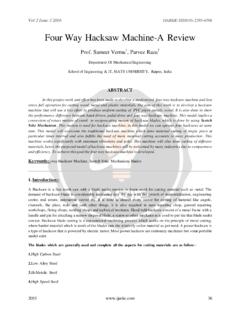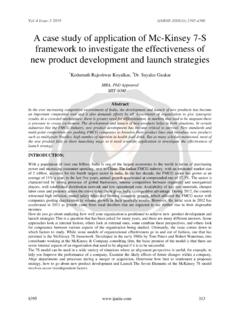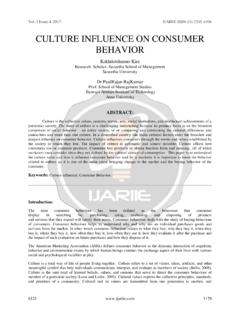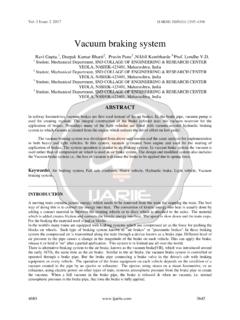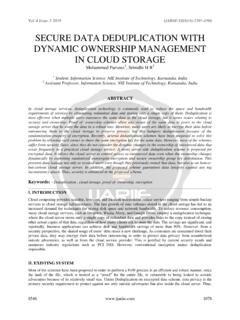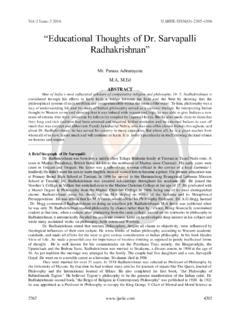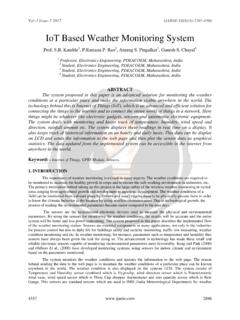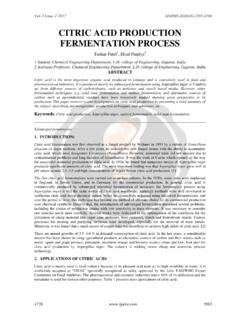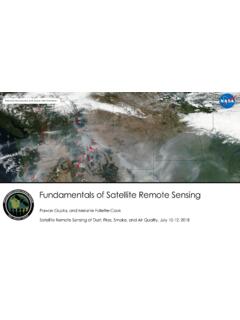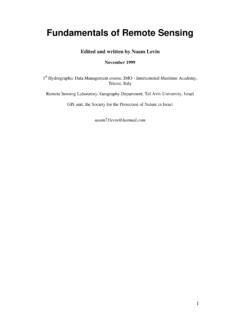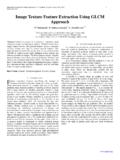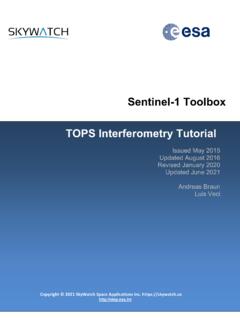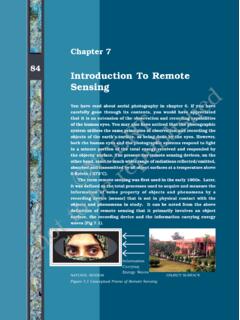Transcription of IMAGE PROCESSING TECHNIQUES AND ITS APPLICATIONS: …
1 Vol-4 Issue-3 2018 IJARIIE-ISSN(O)-2395-4396 8745 2168 IMAGE PROCESSING TECHNIQUES AND ITS APPLICATIONS: AN OVERVIEW Silpa Joseph1 1 Associate Professor, Department of CSE, Viswajyothi College of Engineering & Technology, Kerala, India ABSTRACT The use of digital IMAGE PROCESSING TECHNIQUES has been widely flourished and they are now used for all kinds of tasks in various areas. IMAGE PROCESSING helps in the identification of objects that are invisible, and different TECHNIQUES makes it faster and cost effective. This paper gives you an overview on various digital IMAGE PROCESSING TECHNIQUES and its applications like remote sensing , medical imaging, forensic studies etc. Keyword : - Digital IMAGE PROCESSING , Acquisition, Enhancement, Morphological PROCESSING , Segmentation, Object Recognition and Compression.
2 Digital images play a key role in our day to day life. Millions of digital images are uploaded in every single are the numeric representation of a two-dimensional IMAGE , normally binary. The digital images can be used in various applications like medical imaging, video surveillance, criminal investigations, remote sensing etc. The automatic analysis of images and their signals through various IMAGE PROCESSING TECHNIQUES is of higher importance nowadays . IMAGE PROCESSING and computer vision plays a vital role in any fields related to IMAGE enhancement, manipulation and analysis. IMAGE PROCESSING is a method that performs the analysis and manipulation of digitized images, to improve the quality of IMAGE . Adaptability, recurrence and precision in the original data preservation, are the principle advantages of digital IMAGE PROCESSING methods.
3 Vol-4 Issue-3 2018 IJARIIE-ISSN(O)-2395-4396 8745 2169 Fig-1 IMAGE PROCESSING TECHNIQUES Various IMAGE PROCESSING TECHNIQUES [3] are listed below, IMAGE Acquisition IMAGE Preprocessing IMAGE Enhancement IMAGE Restoration Morphological PROCESSING IMAGE Segmentation Object Recognition IMAGE Data Compression 2. IMAGE PROCESSING TECHNIQUES Some IMAGE PROCESSING technique takes IMAGE as both input and output. Some other TECHNIQUES will take images as input but attributes of images as output. All these TECHNIQUES are not required at a time for the PROCESSING of images. The selection of TECHNIQUES are application specific. The details of various IMAGE PROCESSING TECHNIQUES are as follows. IMAGE Acquisition An IMAGE can be defined as a two-dimensional function, f (u, v), where u and v are plane coordinates, and the amplitude of f at any pair of coordinates (u, v) is called the intensity or gray level of the IMAGE at that point[3].
4 We can call an IMAGE as digital IMAGE , when u, v and the amplitude values of f are all finite, discrete quantities . IMAGE acquisition plays a major role in IMAGE PROCESSING , since if the images are not acquired properly the various IMAGE PROCESSING TECHNIQUES may not be much effective, even with the presence of various enhancement TECHNIQUES . Vol-4 Issue-3 2018 IJARIIE-ISSN(O)-2395-4396 8745 2170 Fig-2 Digital Data Acquisition System Fig-2 denotes a general structure of the data acquisition system. Television camera whose output is a video signal ,is a first choice for a two-dimensional input IMAGE device . These devices show several disadvantages like distortion, limited resolution etc. Charge-coupled device (CCD) camera is considered as the most popular two-dimensional imaging device. IMAGE Preprocessing[3,5] A fundamental step in IMAGE PROCESSING and computer vision is IMAGE preprocessing.
5 The aim of IMAGE preprocessing is the improvement of IMAGE data by enhancing some features while suppressing some unwanted distortions. Enhancing the features depends on specific applications. IMAGE data recorded by sensors on a satellite, consist of errors related to geometry and brightness values of the pixels. In IMAGE preprocessing, these errors are corrected using appropriate mathematical models which are either definite or statistical models. IMAGE preprocessing also includes primitive operations to reduce noise, contrast enhancement, IMAGE smoothing and sharpening, and advanced operations such as IMAGE segmentation. According to the size of the pixel neighborhood that is used for the calculation of a new pixel brightness the IMAGE preprocessing TECHNIQUES can be categorized as, pixel brightness transformations geometric transformations preprocessing TECHNIQUES that use a local neighborhood of the processed pixel IMAGE restoration that requires knowledge about the entire IMAGE IMAGE Enhancement[3] The images captured from some conventional digital cameras and satellite images may lack in contrast and brightness, because of the limitations of imaging subsystems and illumination conditions while capturing an IMAGE .
6 IMAGE enhancement is one of the simplest and alluring technique to overcome this difficulty. Here it enhances some features that are concealed or highlight certain features of interest, for subsequent analysis of an IMAGE . We can categorize the IMAGE enhancement TECHNIQUES into two. They are i)spatial domain method and ii)frequency domain method. Spatial domain method deals with the modification or aggregation of pixels that forms the IMAGE and frequency domain method enhances the IMAGE in a linear manner by positioning the invariant operator. Some of the IMAGE enhancement TECHNIQUES are: i) Contrast Stretching ii) Noise Filtering iii) Histogram Modification Vol-4 Issue-3 2018 IJARIIE-ISSN(O)-2395-4396 8745 2171 IMAGE Restoration [5] The process of recovering degraded or corrupted IMAGE by removing the noise or blur, to improve the appearance of the IMAGE is called IMAGE restoration.
7 The degraded IMAGE is the convolution of the original IMAGE , degraded function, and additive noise. Restoration of the IMAGE is done with the help of prior knowledge of the noise or the disturbance that causes the degradation in the IMAGE . It can be done in two domains: spatial domain and frequency domain. In spatial domain the filtering action for restoring the images is done directly on the operating pixels of the digital IMAGE and in frequency domain the filtering action is done by mapping the spatial domain into the frequency domain, by fourier transform. After the filtering, the IMAGE is remapped by inverse fourier transform into spatial domain, to obtain the restored IMAGE . We can choose any of the domains based on the applications required. Fig-3 Classification of IMAGE Restoration TECHNIQUES IMAGE restoration models can be classified into two as shown in Fig-3, based upon the knowledge of the degradation of the IMAGE .
8 We can select deterministic TECHNIQUES , if there is prior knowledge of the degradation and can select stochastic TECHNIQUES if the degradation of the IMAGE is unknown. Morphological PROCESSING [5,17] Morphological PROCESSING is a collection of linear operations that is used for extracting IMAGE components that are useful in the representation and description of shape. Structuring element is a small set to probe an IMAGE under study. Structuring element is compared with the corresponding neighborhood of pixels by positioning it, at all possible locations in the IMAGE . Some operations check whether the element "fits" within the neighborhood, while others check whether it "hits" or intersects the neighborhood. The basic morphological operations are dilation, erosion and their combinations.
9 Erosion is useful for the removal of structures of certain shape and size ,which is given by the structuring element while dilation is useful in filling of holes of certain size and shape given by the structuring element. Restoration models Stochastic models Deterministic models Linear Filter Non-linear filter Inverse Filter Pseudo Inverse Filter Weiner filter Constrained Least Square Filter Iterative method Iterative Constrained Least Square method Maximum Likelihood method Vol-4 Issue-3 2018 IJARIIE-ISSN(O)-2395-4396 8745 2172 Fig-4(a) shows an example binary IMAGE . Fig 4(b) to 4(e) shows the result of applying the different morphological operations to the IMAGE in 4(a) IMAGE Segmentation IMAGE Segmentation is the process of partitioning a digital IMAGE into multiple segments, to simplify and/or change the representation of an IMAGE into something that is more meaningful and easier to analyze.
10 It may make use of statistical classification, thresholding , edge detection, region detection, or any combination of these TECHNIQUES . Usually a set of classified elements is obtained as the output of the segmentation step. Segmentation TECHNIQUES can be classified as either region-based or edge-based. The former TECHNIQUES rely on common patterns in intensity values within a cluster of neighboring pixels, and the goal of the segmentation algorithm is to group regions according to their anatomical or functional roles. The edge-based TECHNIQUES rely on discontinuities in IMAGE values between distinct regions, and the goal of the segmentation algorithm is to accurately demarcate the boundary separating these regions. Object Recognition[2] Object Recognition is the process that provides a label to an object in a digital IMAGE or video ,based on its :-vehicle.
